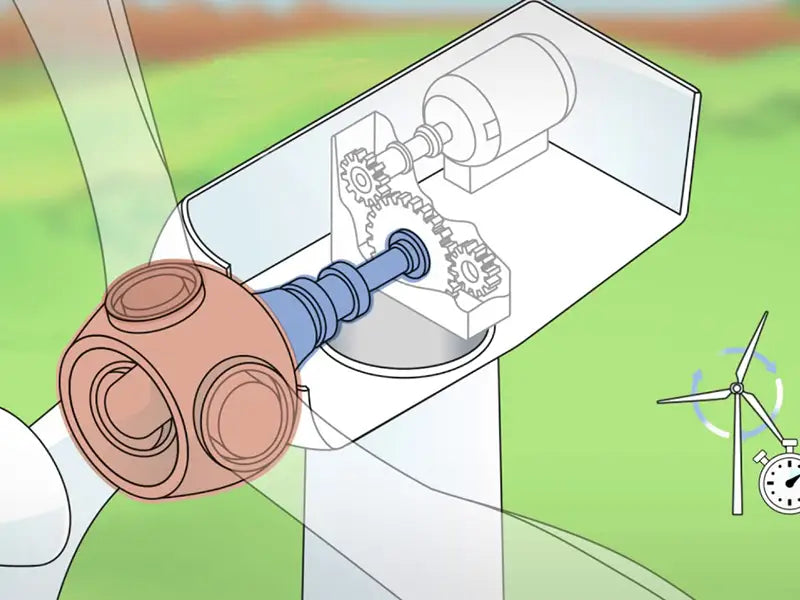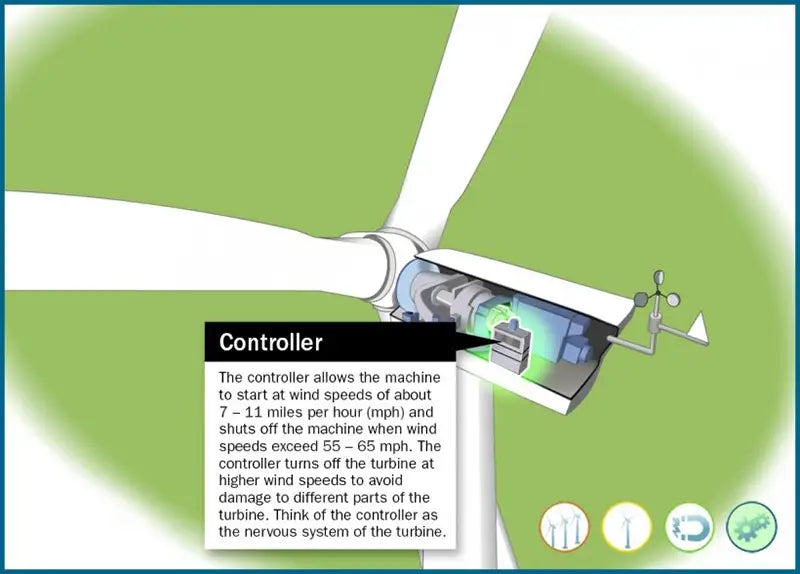
Main content:
- The variable speed wind turbine drives the alternator to run through the inverter and grid-connected
- The wind turbine directly drives the low-speed alternator and grid-connected to via the inverter
- The variable speed wind turbine drives the synchronous generator through the slip connector and grid-connected
1. The variable speed wind turbine drives the alternator to run through the inverter and grid-connected

In such a grid-connected wind power generation system, the wind turbine may be a horizontal-axis pitch-controlled or stall-controlled fixed-pitch wind turbine, or a vertical-axis wind turbine, such as a Darrieux-type wind turbine.
In this grid-connected wind power generation system, the wind turbine operates at a variable speed, so the alternator sends out a variable-frequency alternating current, which is converted by a rectifier-inverter device to obtain a constant-frequency alternating current output, which is then connected in parallel with the power grid. The grid-connected wind power system is also a wind power system with variable speed and constant frequency grid-connected operation.
As mentioned above, when the grid-connected wind turbine operates at variable speed, the grid-connected wind turbine can be maintained at or close to the optimal tip speed ratio, so that the C, value of the grid-connected wind turbine can reach or be close to the optimal value, so as to achieve better utilization of wind energy. the goal of.
In this relationship, since the alternator is connected to the grid through a rectifier-inverting device, the frequency of the generator and the frequency of the grid are independent of each other, so there is usually no occurrence of the frequency difference when the synchronous generator is connected to the grid. It is a better and stable way to connect to the grid.
The disadvantage of this grid-connected wind power generation system is that all the AC power generated by the alternator needs to be converted by a rectifier-inverter device and then sent to the grid. It is higher and the control is more complicated. In addition, the high-frequency harmonic current generated by the non-sinusoidal inverter during operation flows into the power grid, which will affect the power quality of the power grid.
2. The wind turbine directly drives the low-speed alternator and grid-connected to via the inverter

The characteristic of this grid-connected wind power generation system is that, due to the use of a low-speed alternator, there is no need to install a speed-up gearbox between the grid-connected wind turbine and the alternator, and it becomes a direct drive type without a gearbox.
The low-speed alternator in this grid-connected wind power generation system has many more poles in the rotor than the ordinary alternator. Therefore, the outer circumference of the rotor and the inner diameter of the stator of this kind of motor are greatly increased, while its The axial length is relatively short and is annular. In order to simplify the structure of the motor and reduce the volume and mass of the generator, it is advantageous to use permanent magnet excitation.
Since IGBT is a composite power electronic device that combines the characteristics of high-power transistors and power field-effect transistors, it not only has the advantages of fast working speed and low driving power, but also has the large current capacity and conduction of high-power transistors. Therefore, IGBT inverters are often used in such grid-connected systems.
The main advantages of the grid-connected wind power generation system with direct drive without gearbox are as follows:
(1) Since the gearbox is not used, the length of the horizontal axis of the unit is greatly reduced, and the mechanical transmission path for electric energy generation is shortened, avoiding the loss, noise, material wear and even oil leakage caused by the rotation of the gearbox. The working life of the unit is more guaranteed, and it is more suitable for the requirements of environmental protection.
(2) The maintenance and replacement of gearbox components are avoided, and the lubricating oil in the gearbox hole and the monitoring of the oil temperature are not required, thus improving the effectiveness of the investment.
(3) Since the generator has a large surface, the heat dissipation conditions are more favorable, which can reduce the temperature rise of the generator during operation and reduce the fluctuation of the temperature rise of the generator.
Both Germany and Canada have researched and developed medium and large gearless direct-drive wind turbines, and Germany has mass-produced large and medium-sized wind turbines with a capacity of 500 kW and 1.5 MW.
3. The variable speed wind turbine drives the synchronous generator through the slip connector and grid-connected

As mentioned above, when the grid-connected wind turbine drives the synchronous generator in parallel with the power grid, when the wind speed changes and the grid-connected wind power machine runs at a variable speed, the output end of the synchronous generator will send out alternating current with variable frequency and variable voltage, which cannot be connected in parallel with the power grid. If the electromagnetic slip connector is used to connect the grid-connected wind turbine and the synchronous generator, when the grid-connected wind turbine is running at a variable speed, the synchronous generator can send out constant frequency and constant voltage alternating current with the help of the electromagnetic slip connector to realize the connection with the power grid. run in parallel.
The electromagnetic slip connector is a special electric machine, it acts as a clutch, it consists of two rotating parts, one rotating part is connected with the prime mover, the other rotating part is connected with the driven machine, these two rotating parts There is no mechanical connection between the parts, but the elastic connection between the prime mover and the driven machine is realized by electromagnetic action and the torque is transmitted. From a structural point of view, the electromagnetic clearance connector is similar to the slip motor. In the above figure, it is composed of an electric plate, a magnetic pole, an excitation winding, a slip ring and a brush. The excitation winding is supplied with current by the thyristor rectifier, and the magnitude of the excitation current is controlled by the thyristor.
The working principle of this grid-connected system is as follows: when the rotational speed of the grid-connected wind turbine changes due to the change of wind speed, the rotational speed of the driving shaft of the electromagnetic slip connector will change accordingly, but the electromagnetic slip connected to the synchronous generator will change accordingly. The speed of the connected driven shaft is automatically adjusted through the negative feedback of the speed to maintain the excitation current of the electromagnetic slip connector, that is, the speed difference between the driving shaft and the driven shaft of the electromagnetic slip connector is corresponding. It can be ensured by the change of excitation current, which can be seen from the mechanical characteristics of electromagnetic slip connectors with different excitation currents.
Read more: The wind turbine drives the two-speed asynchronous generator to run in parallel with the grid